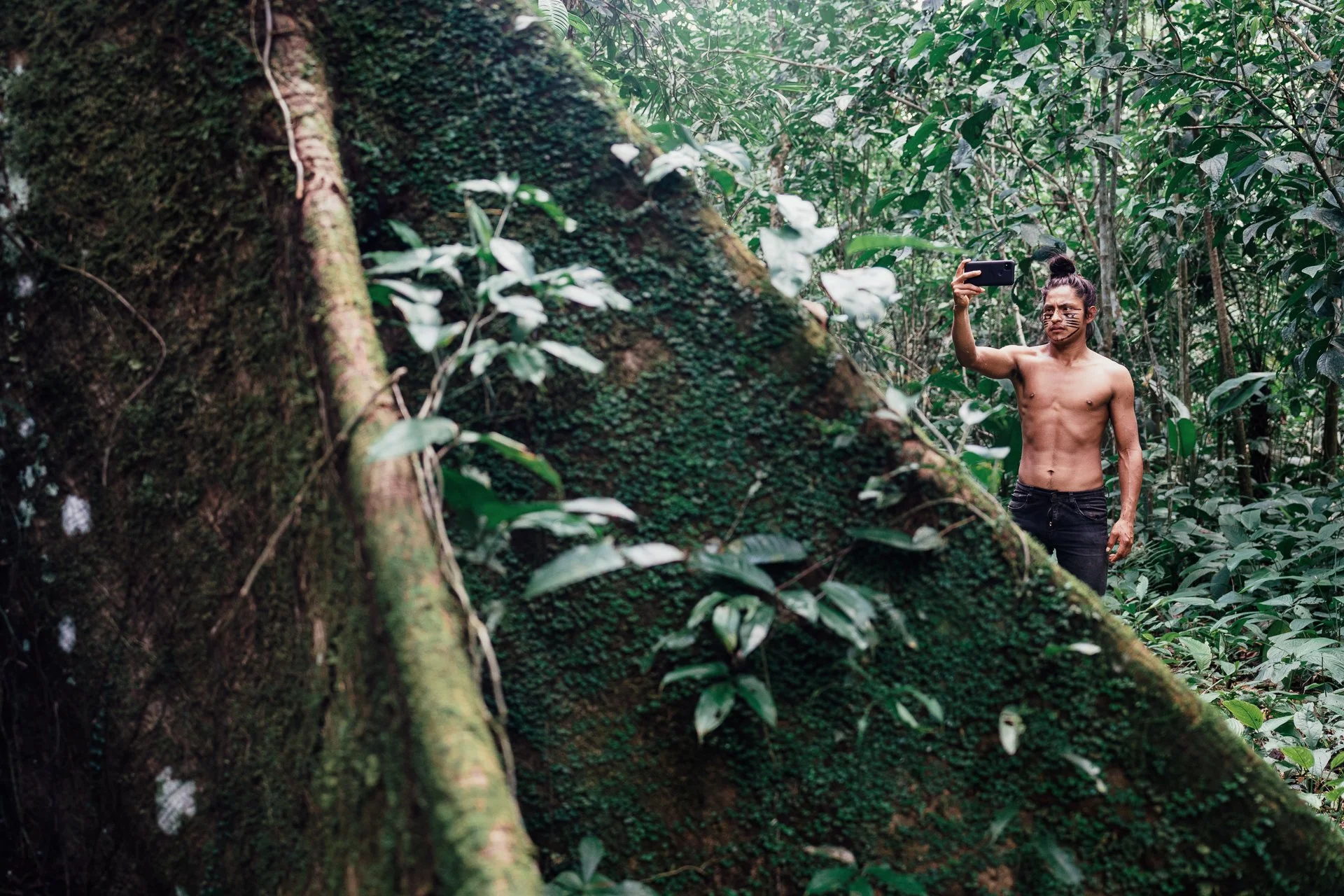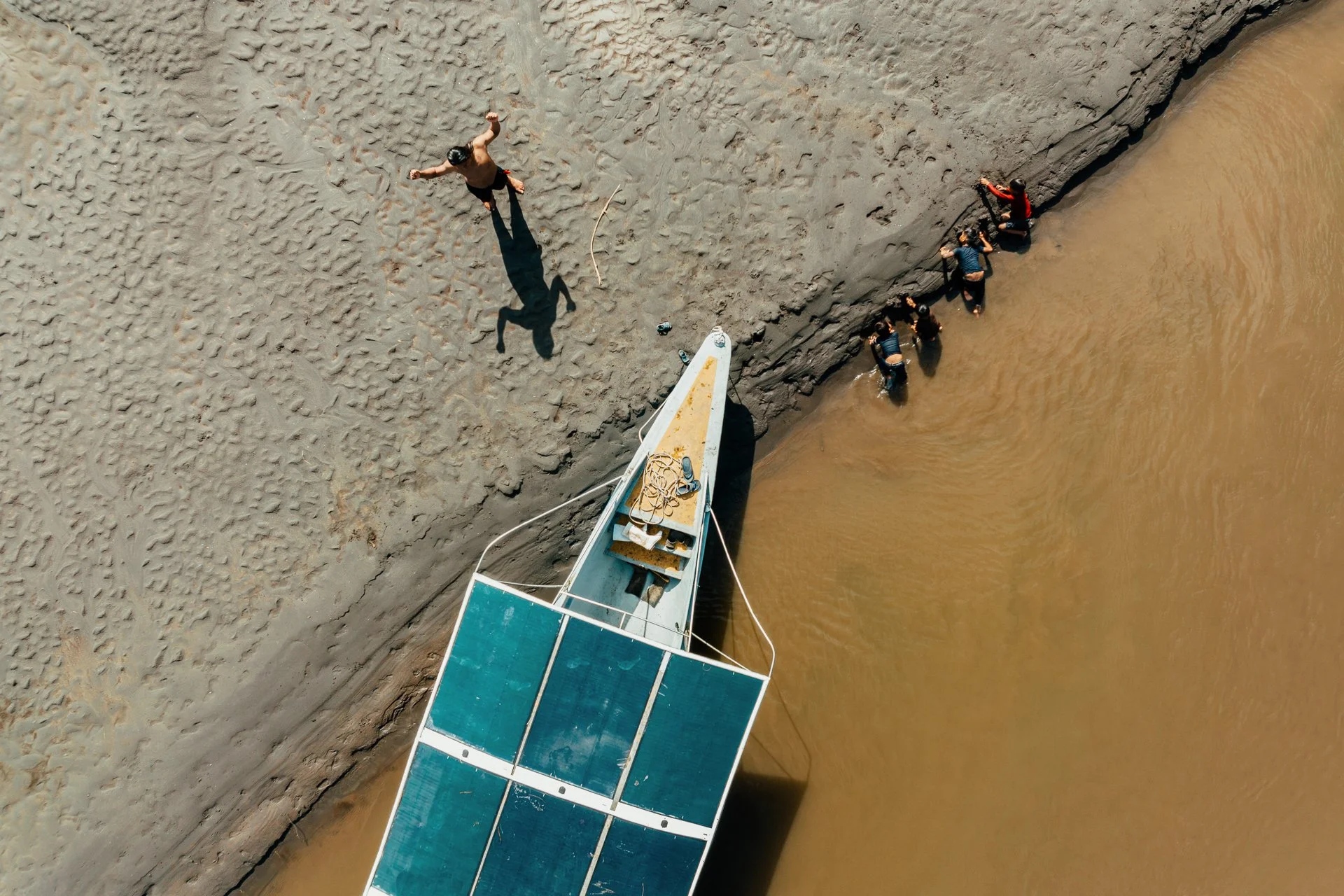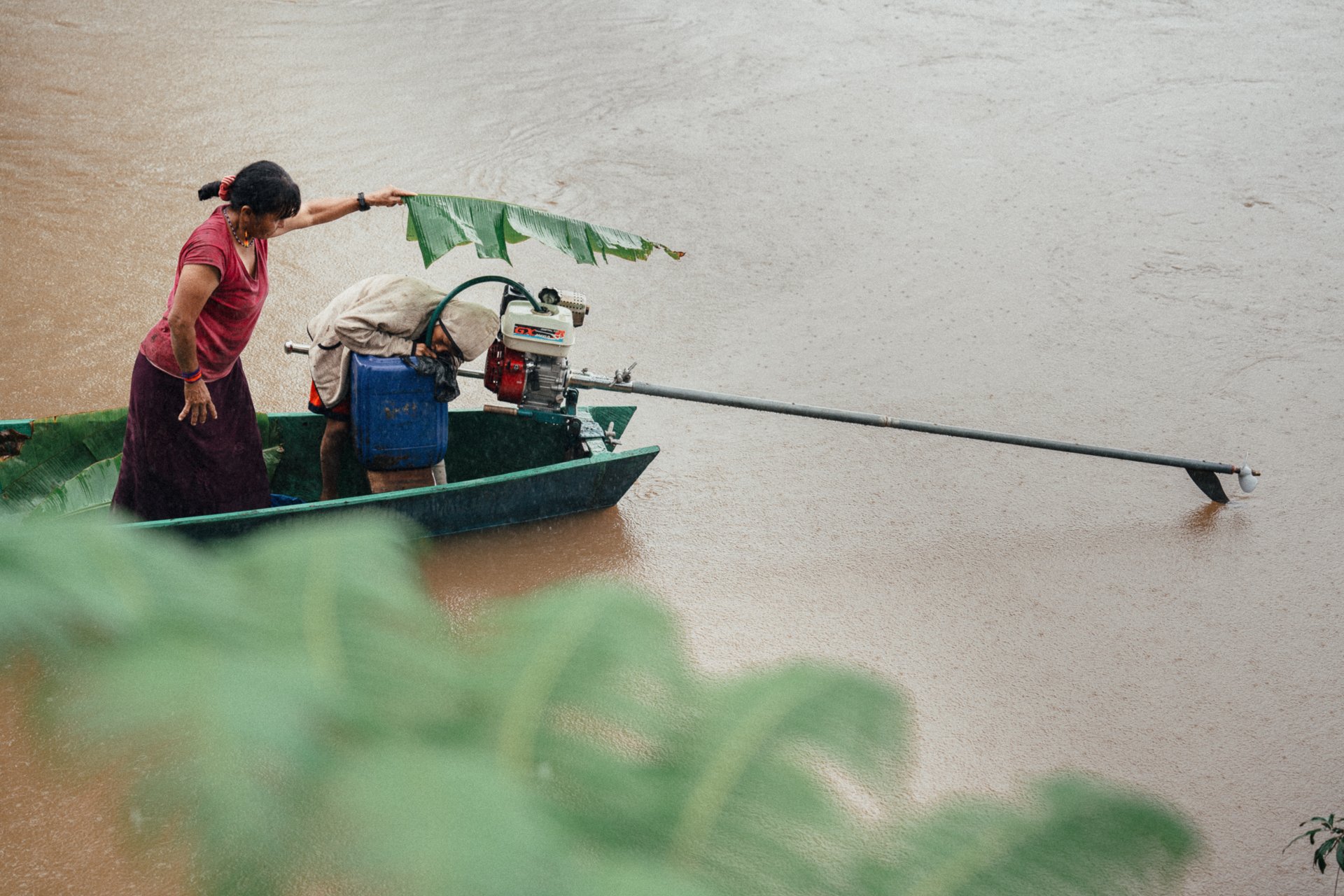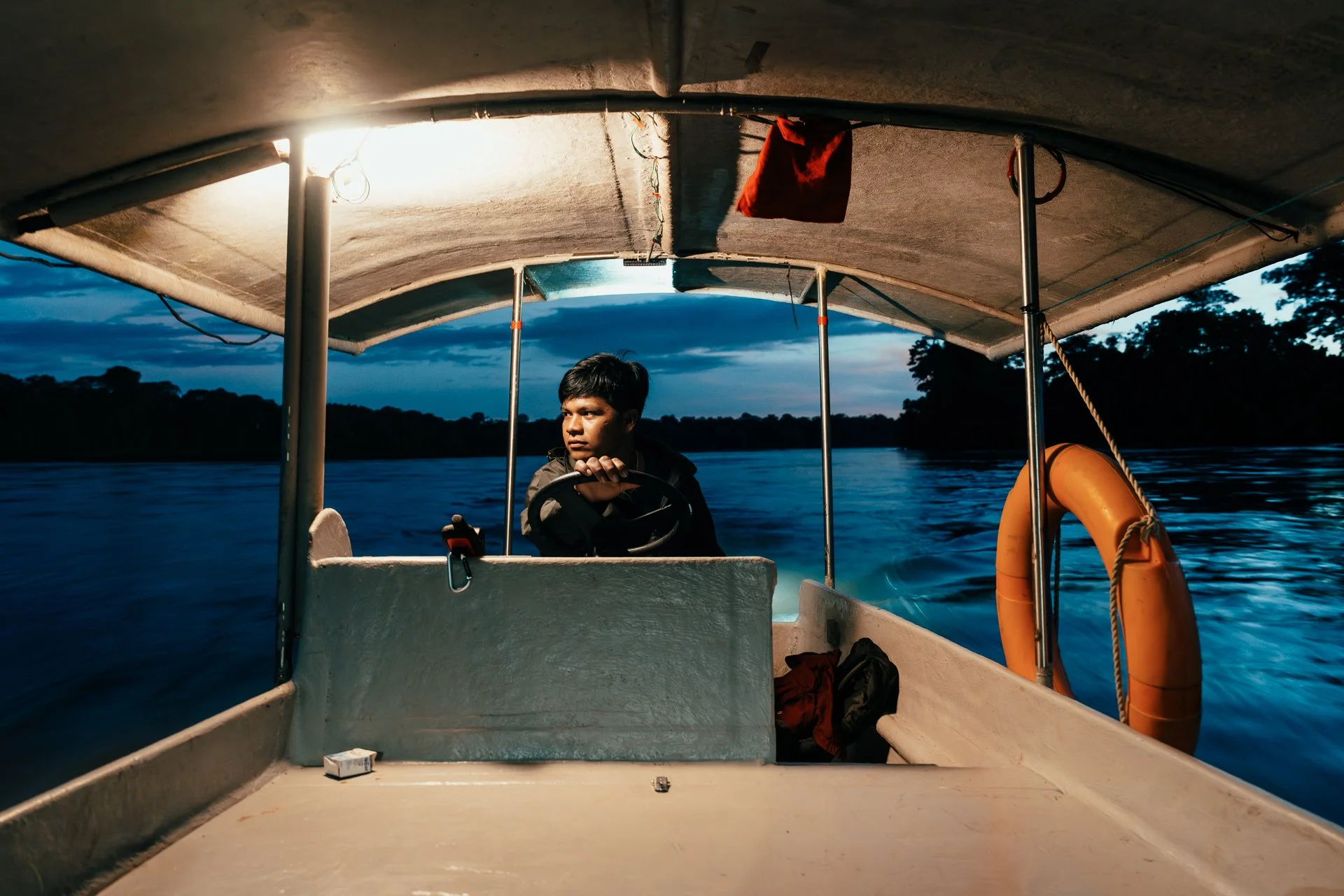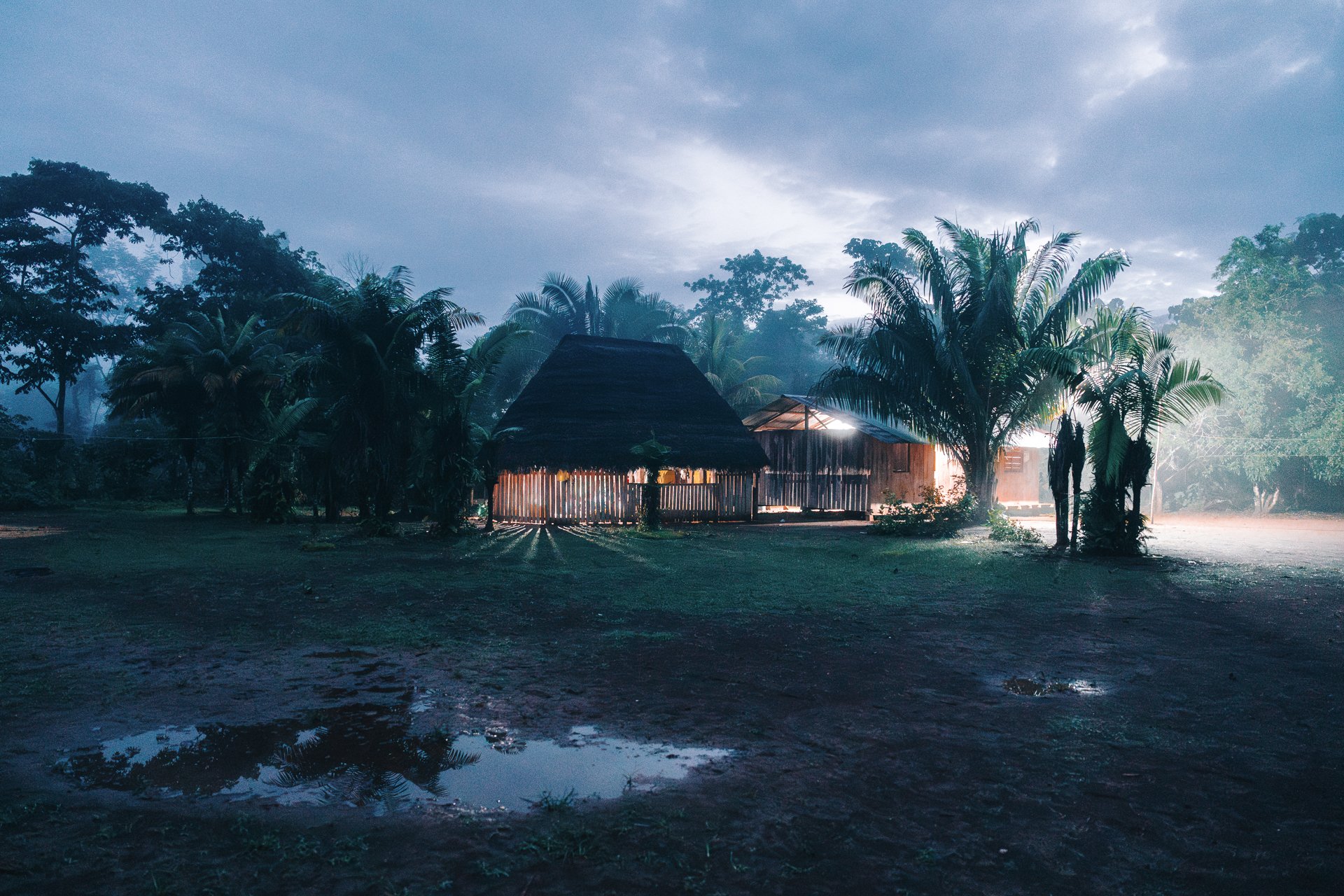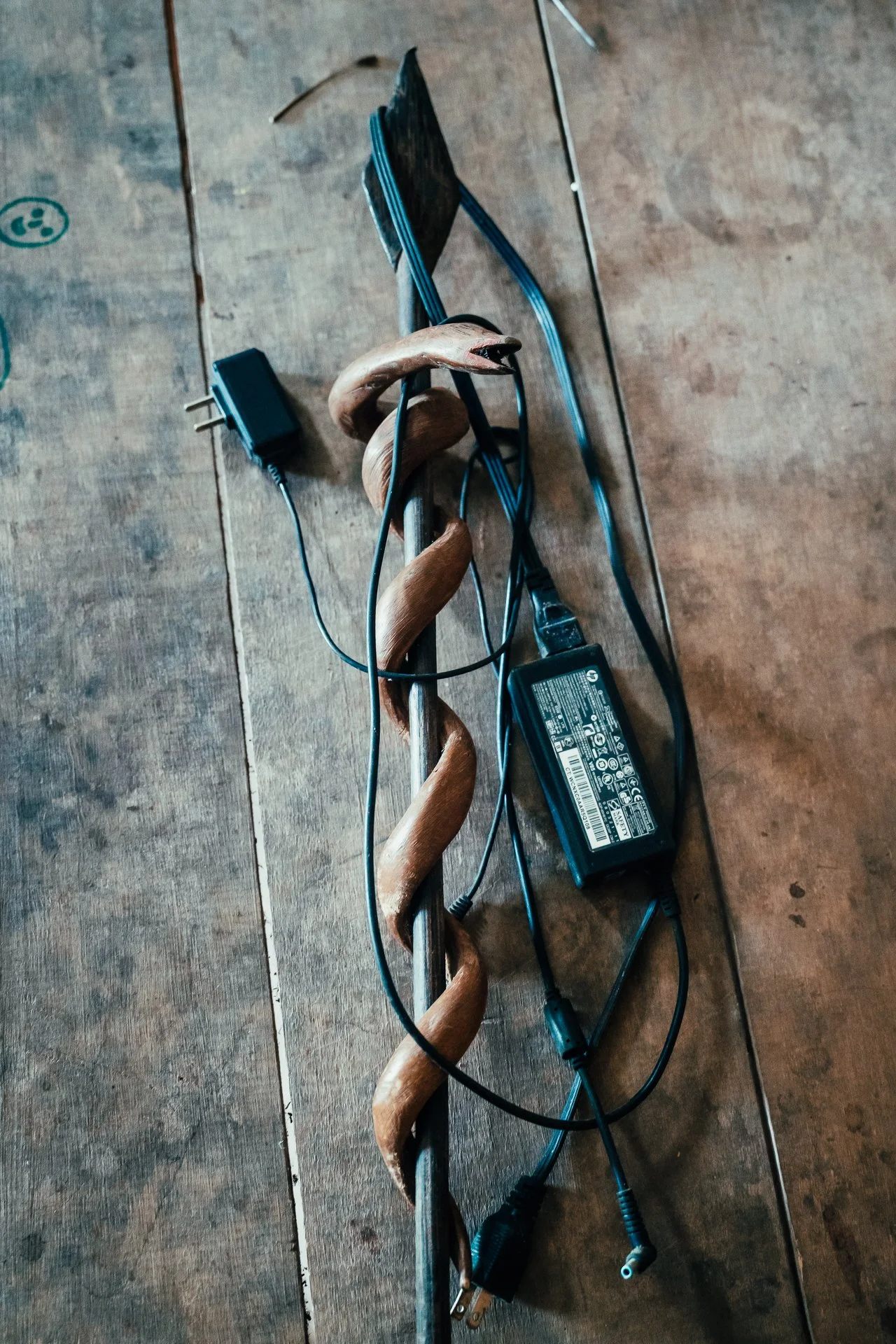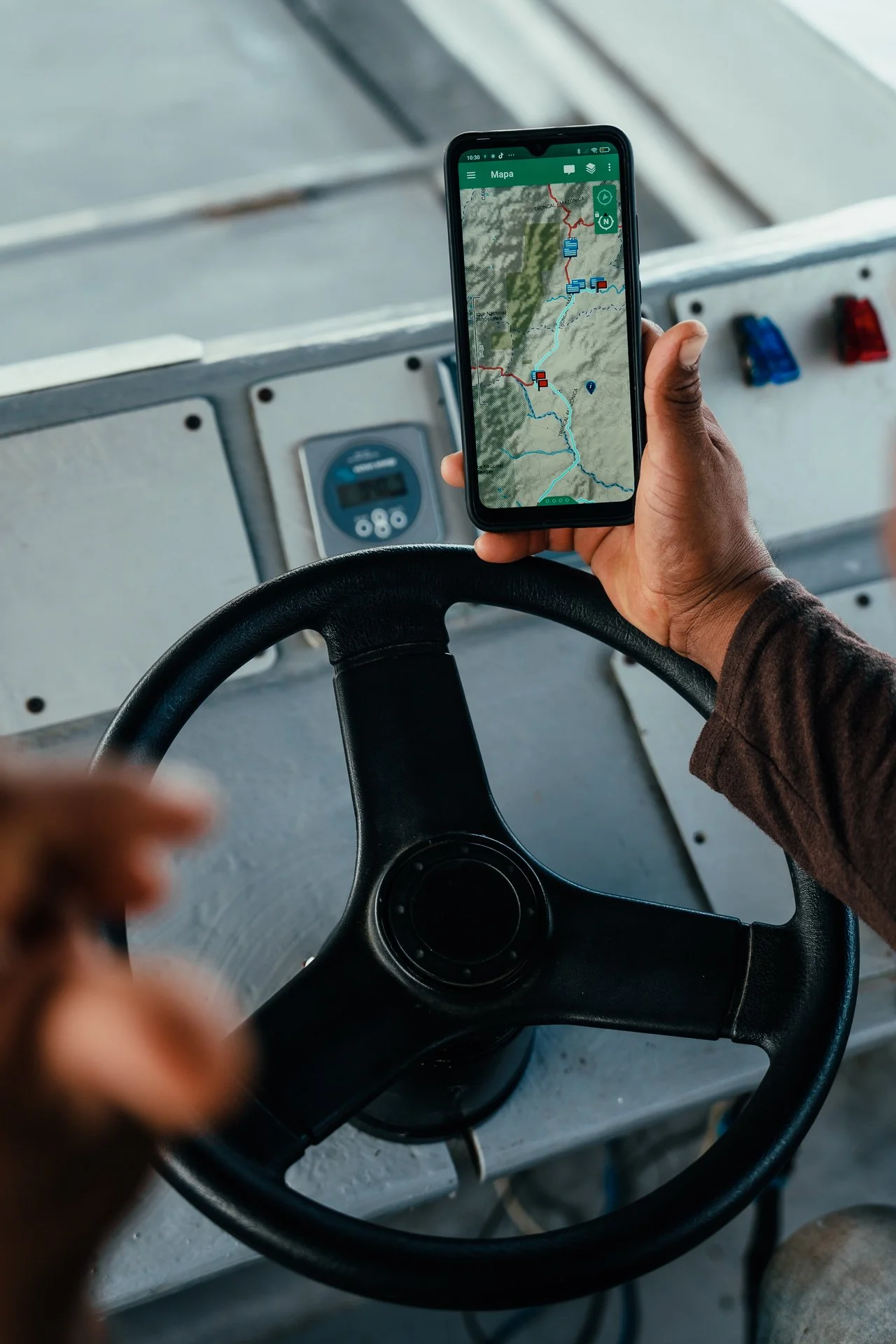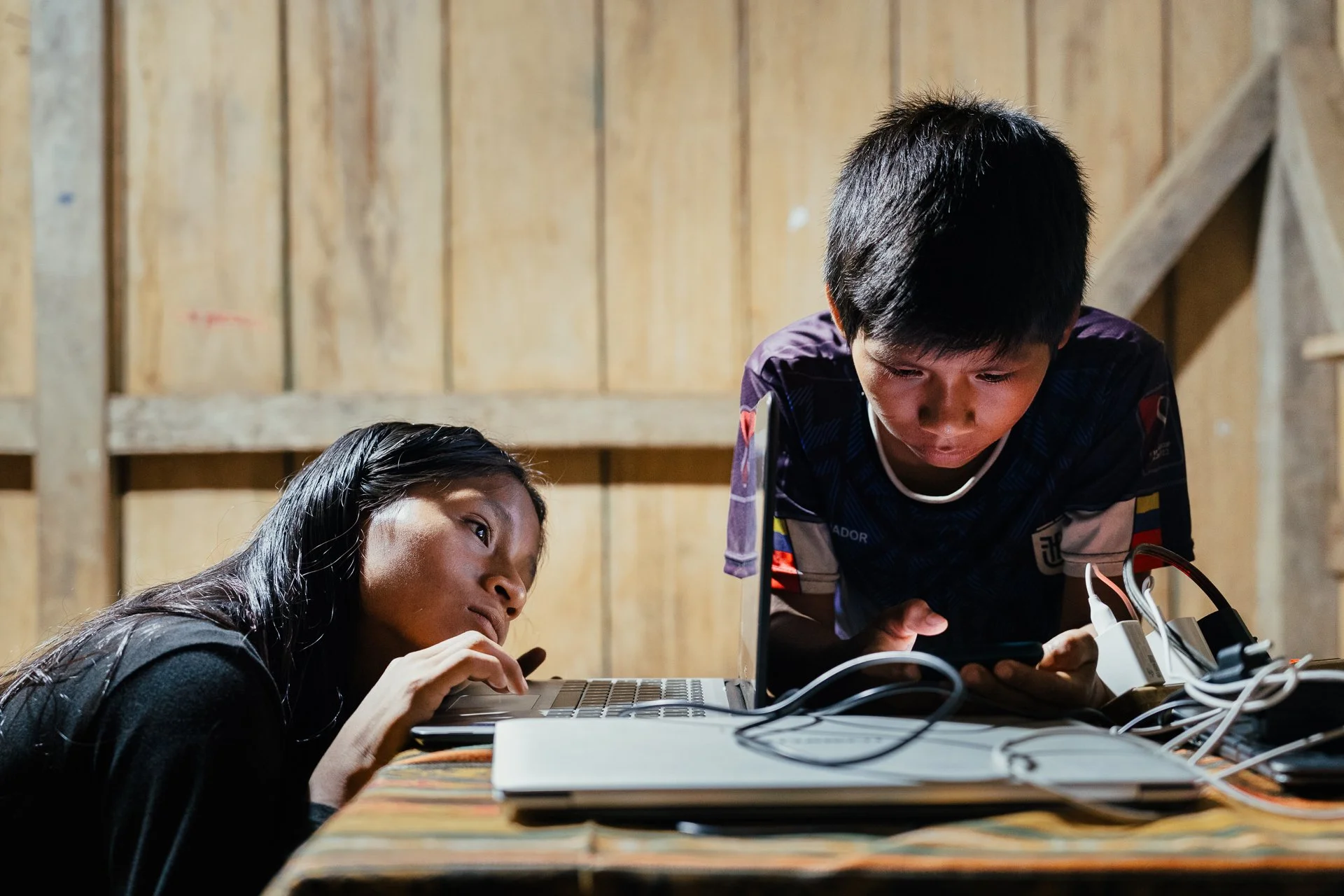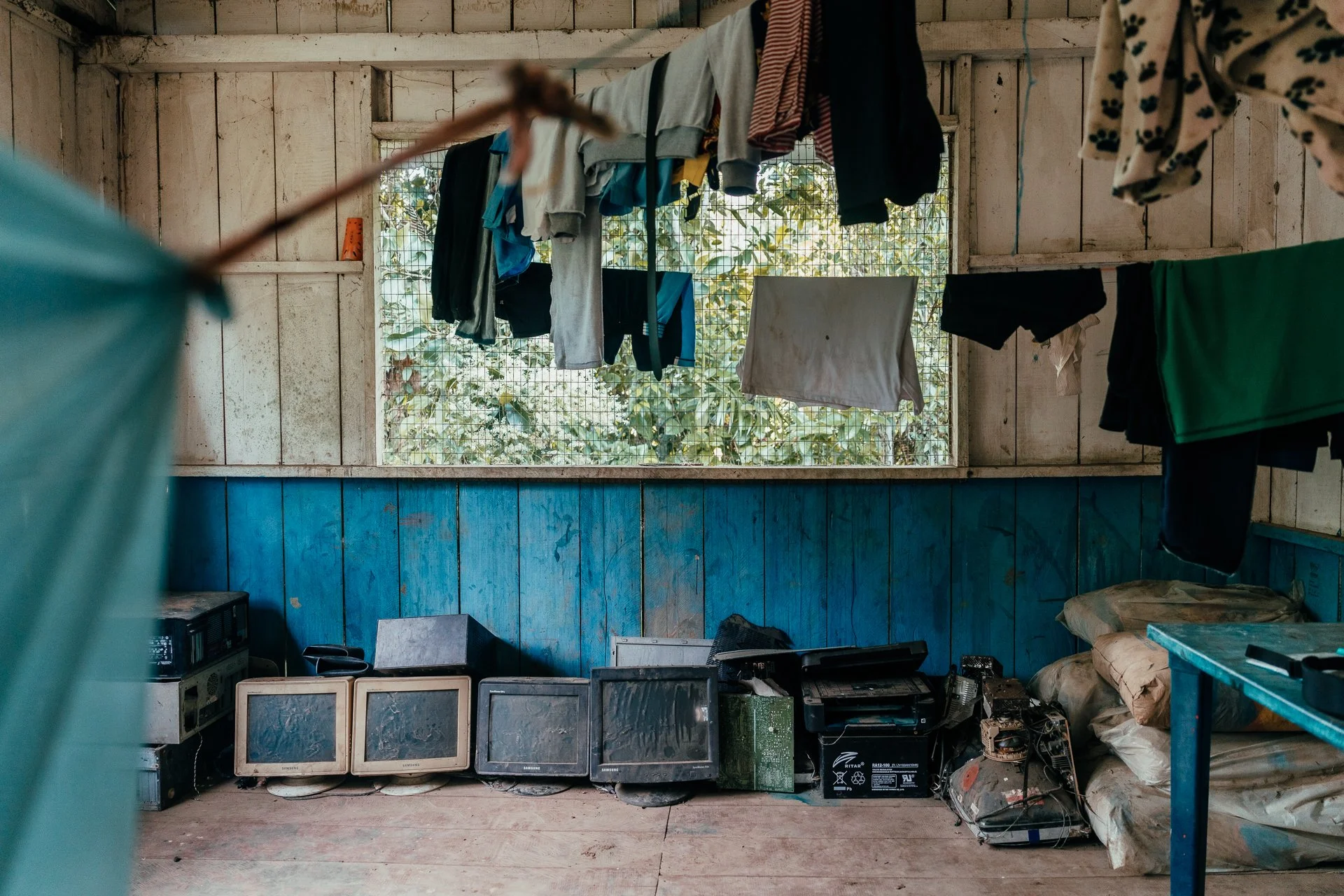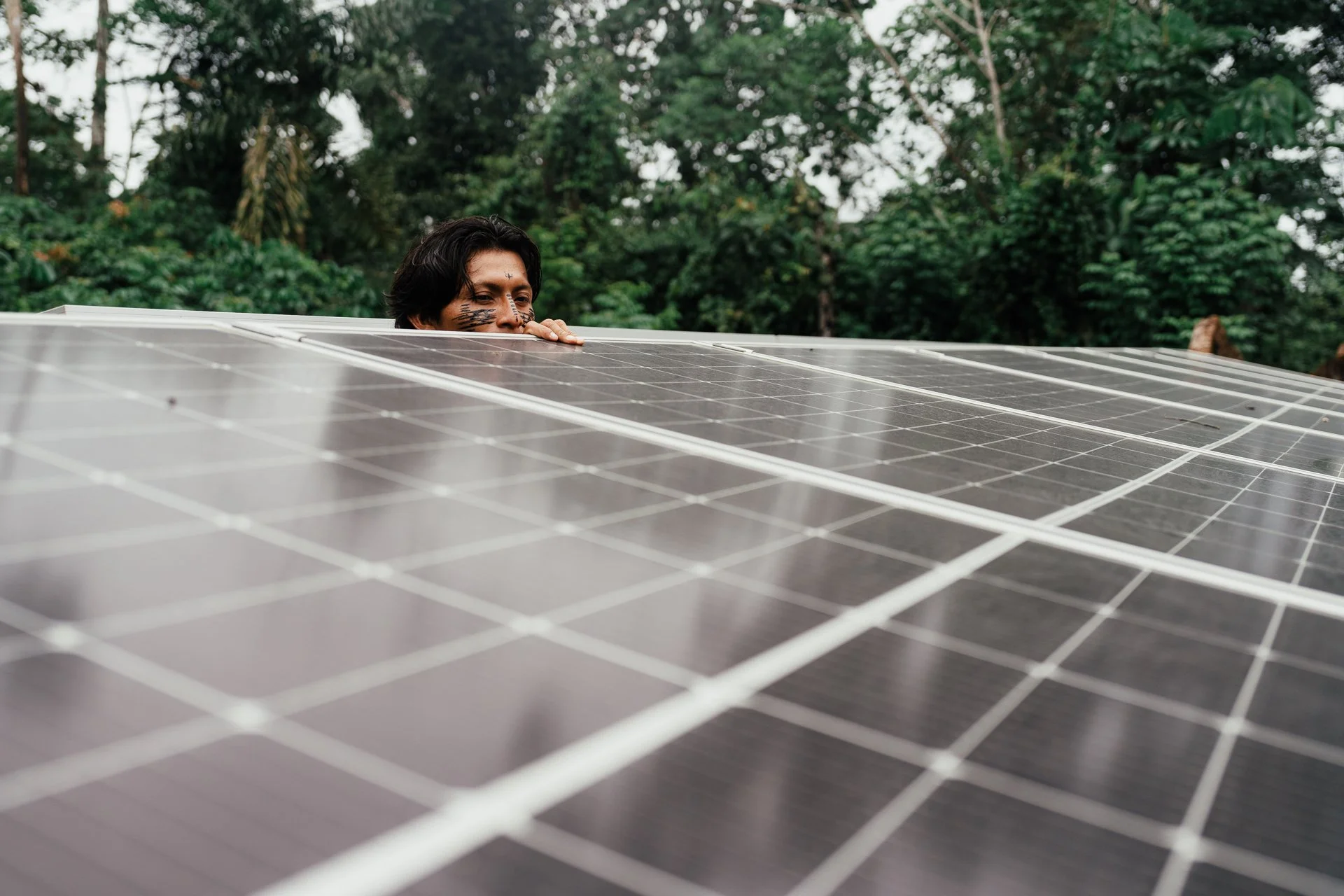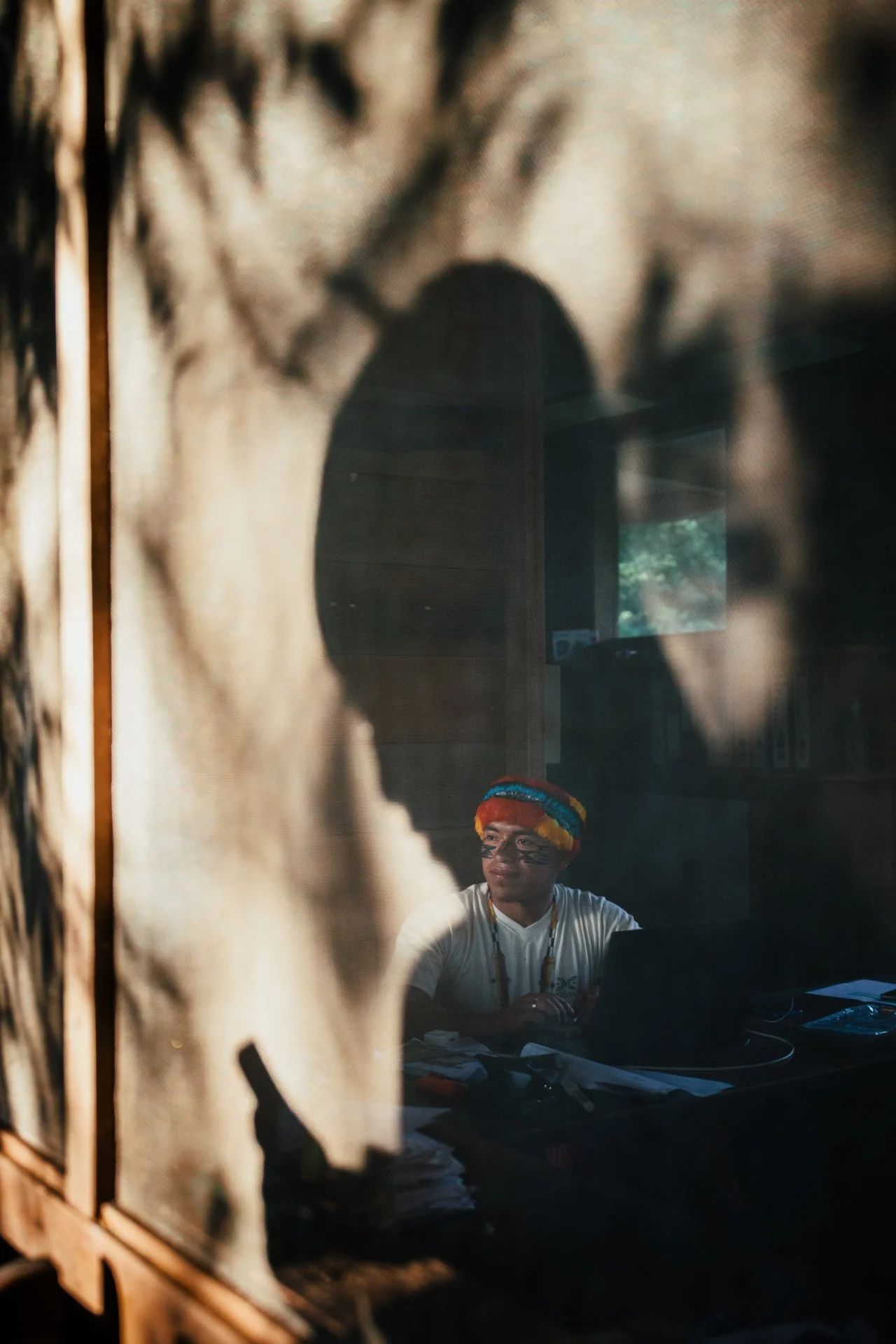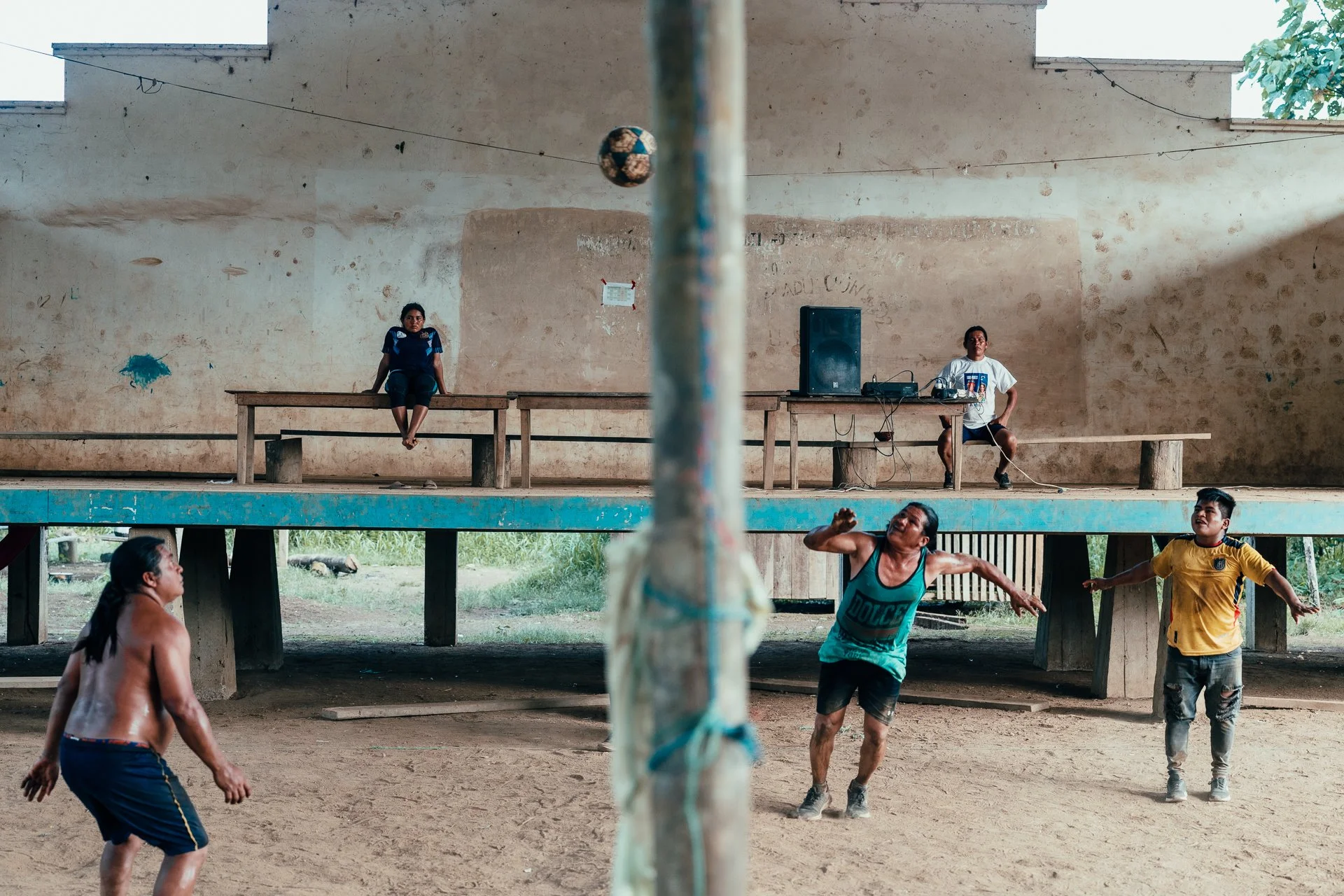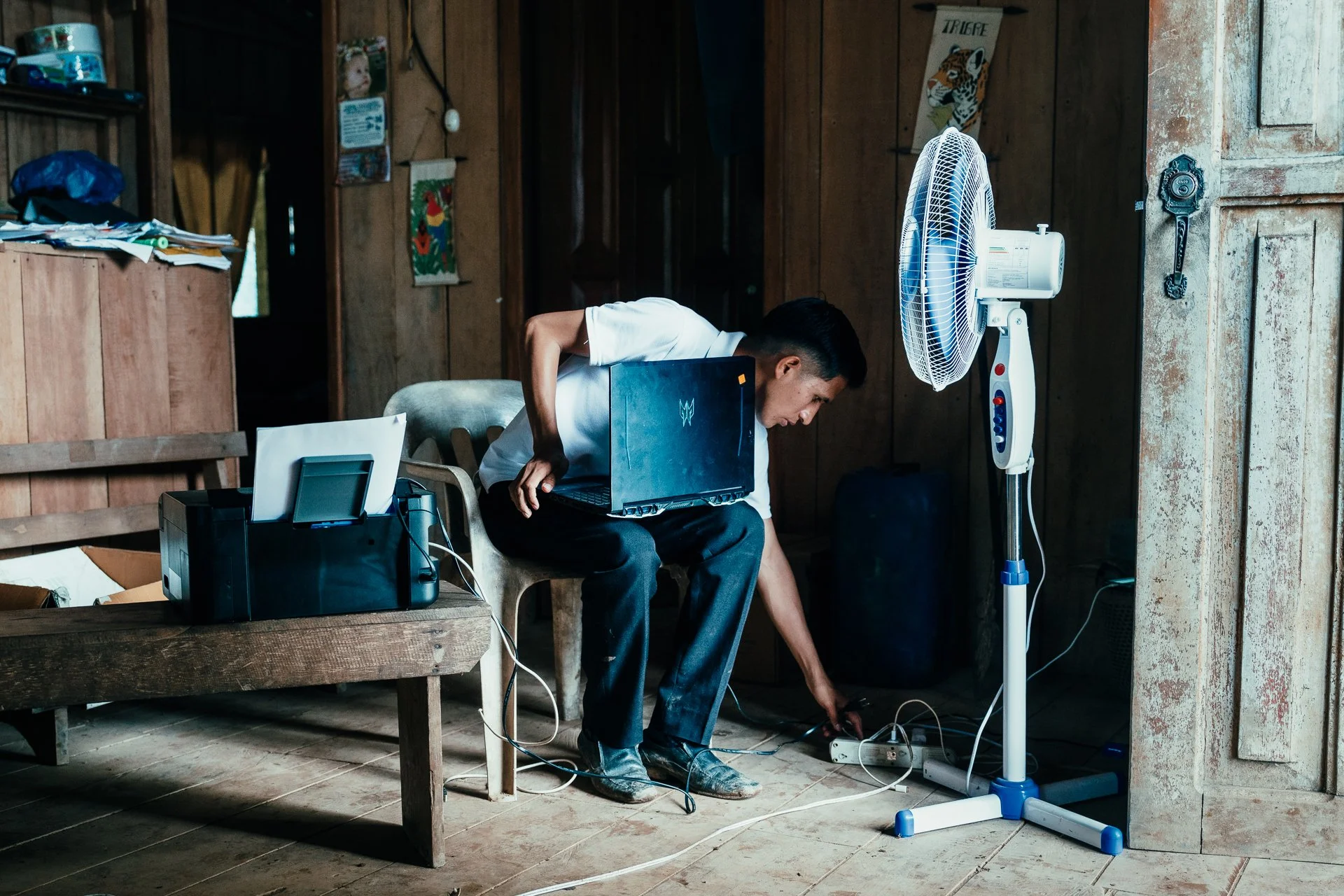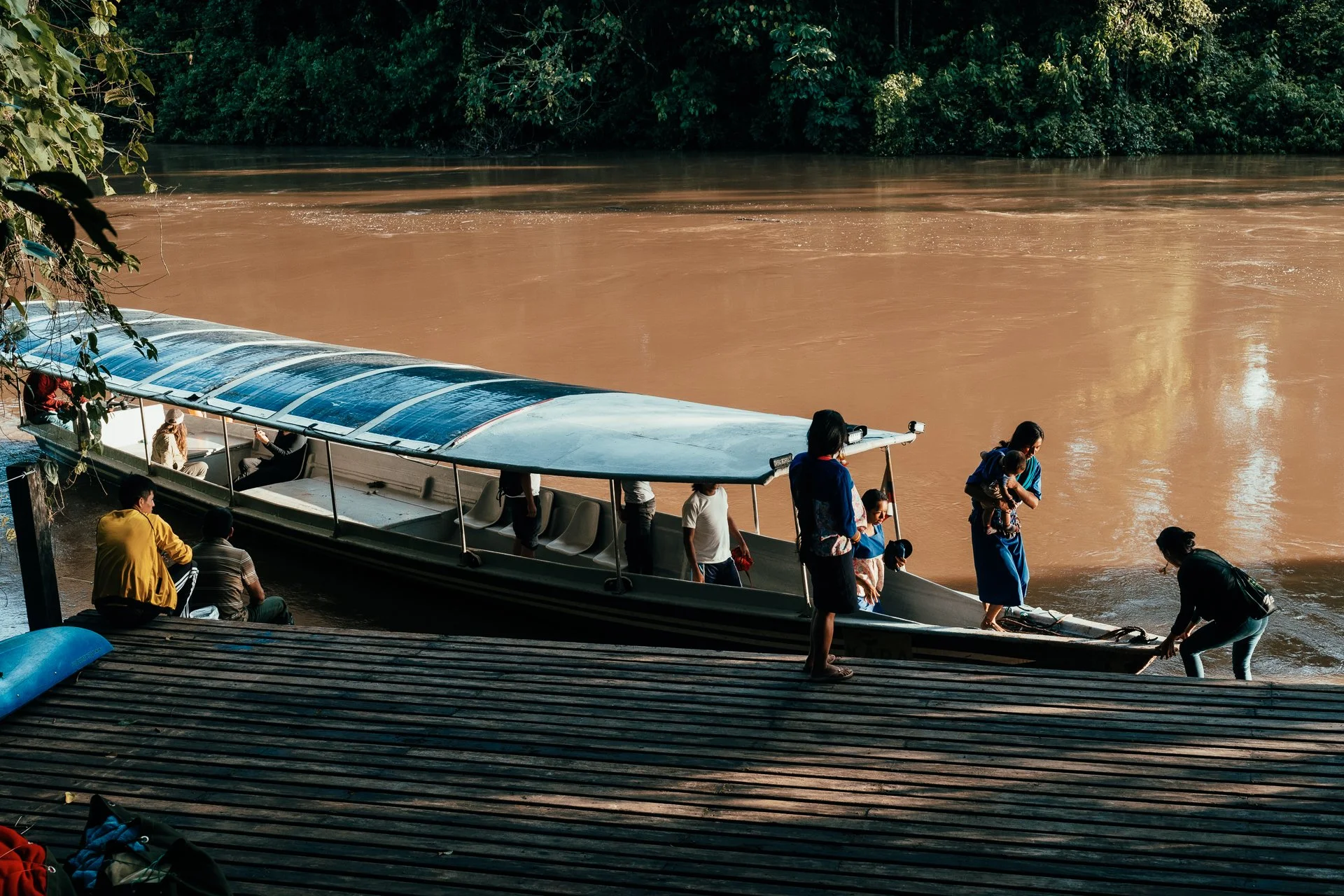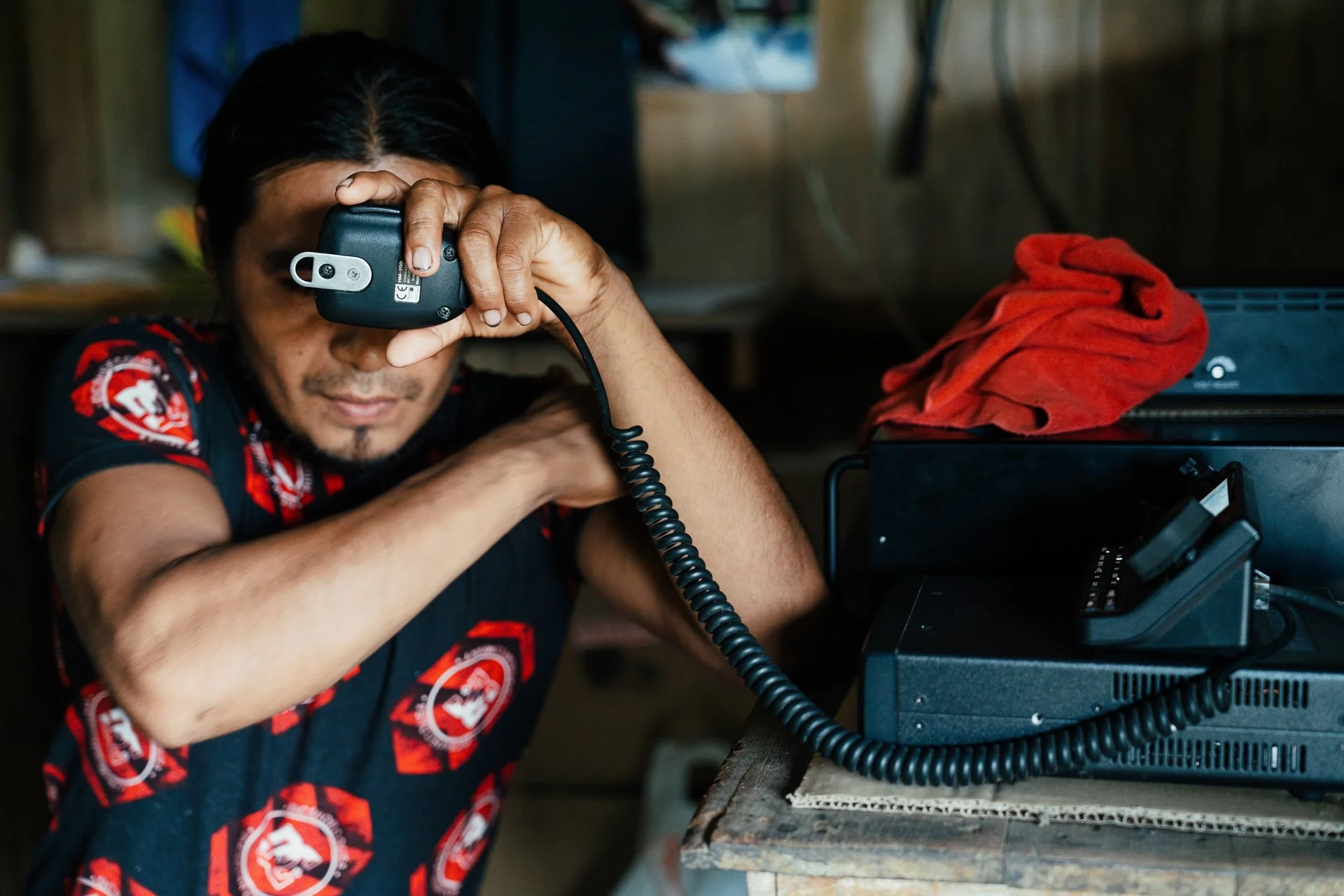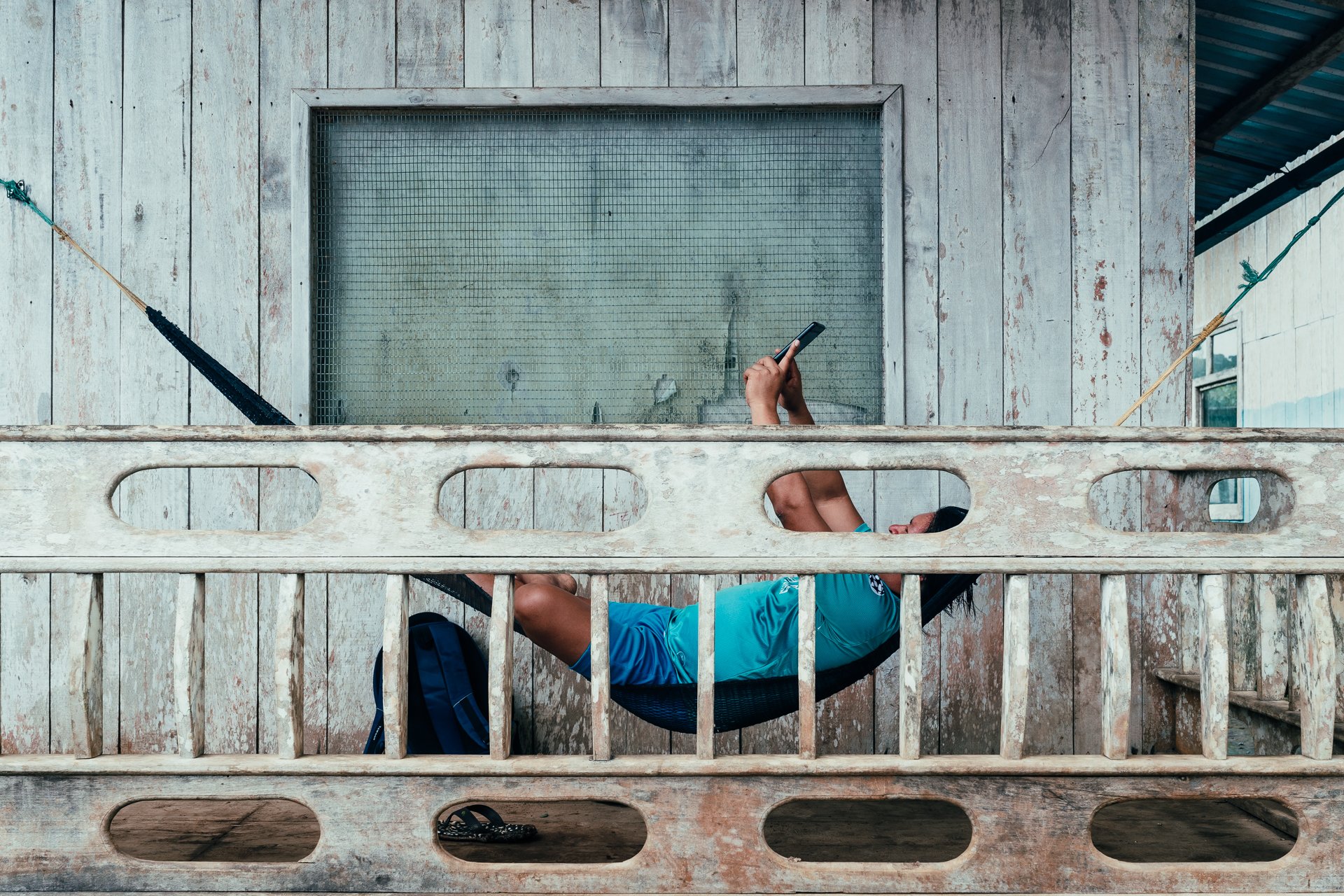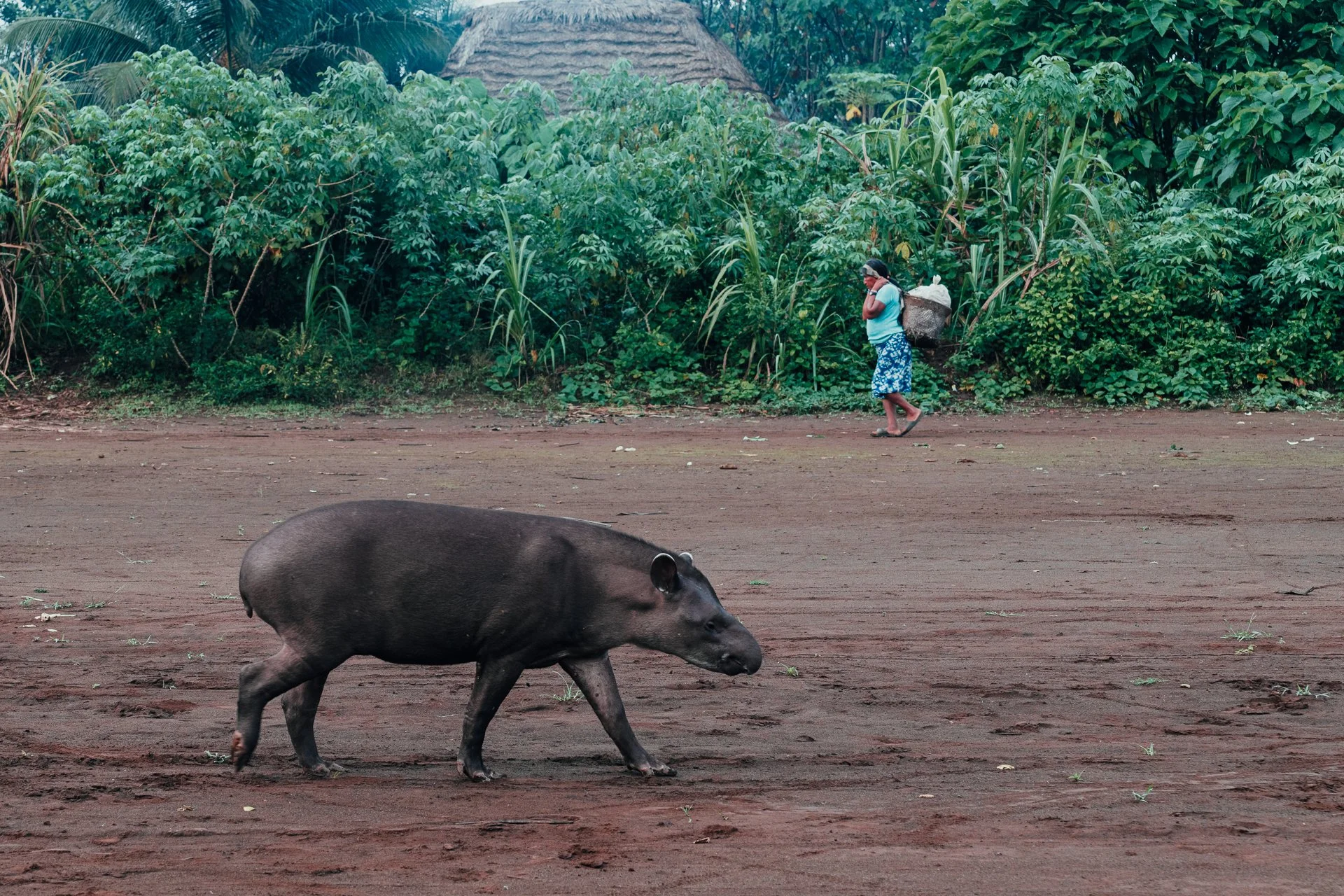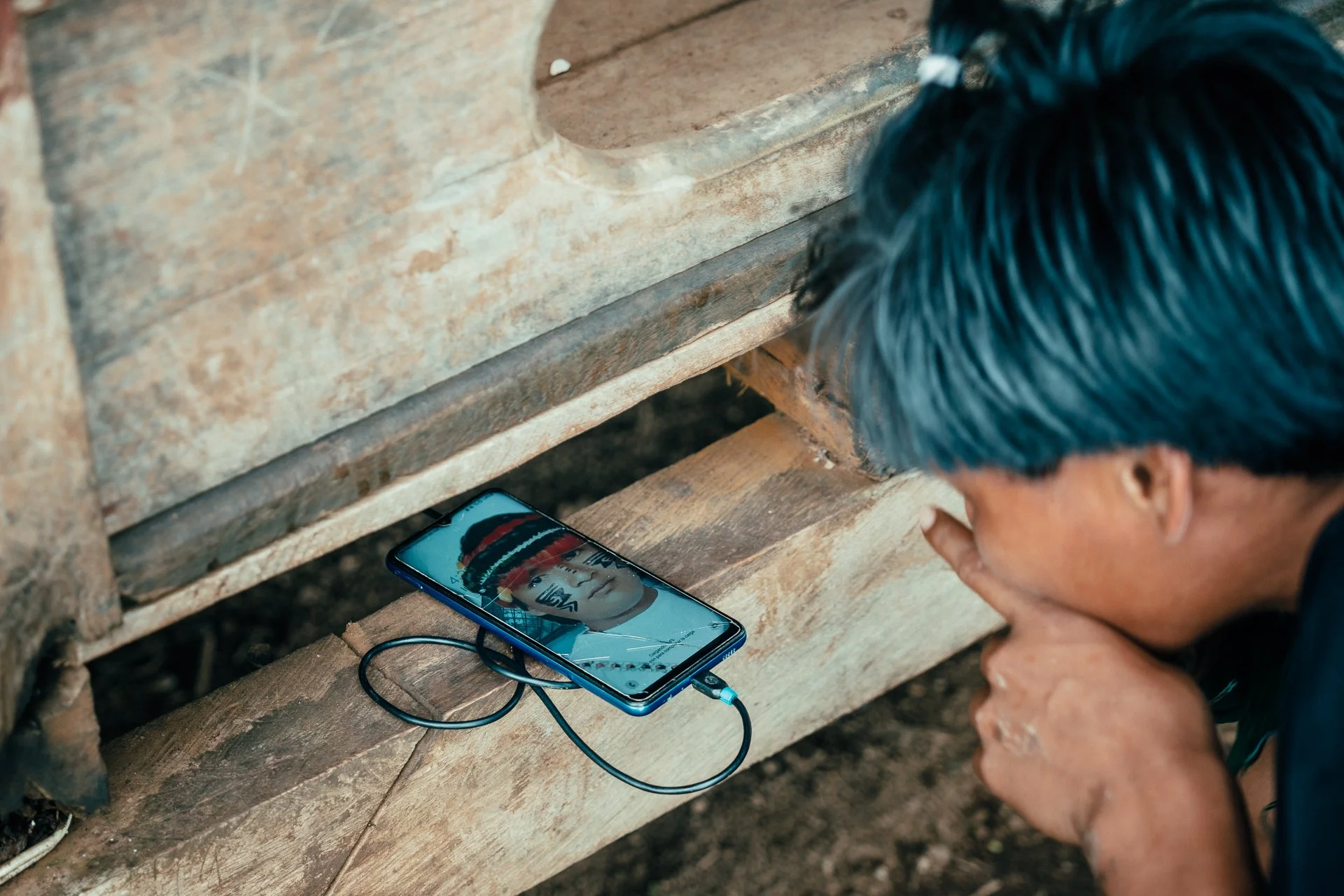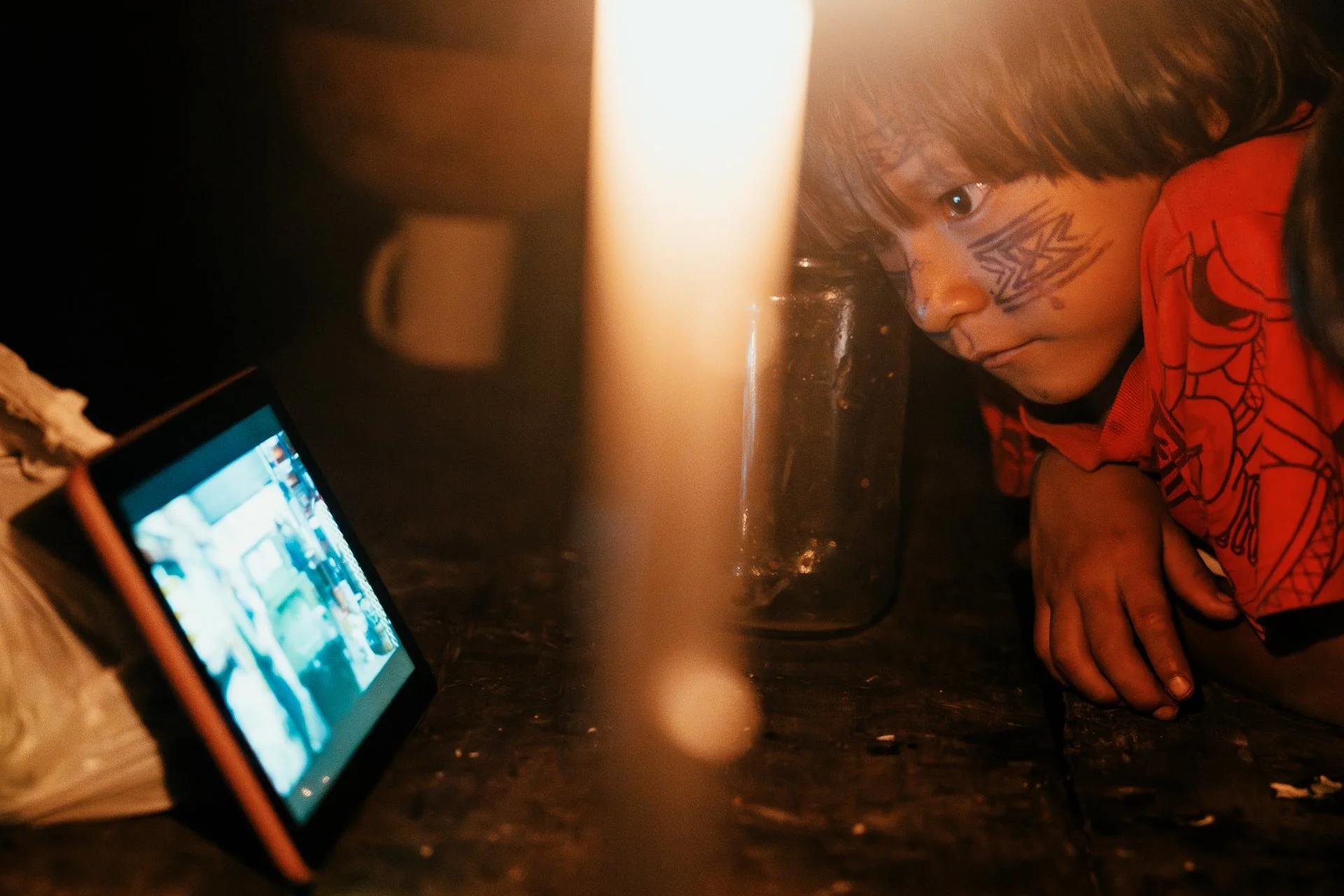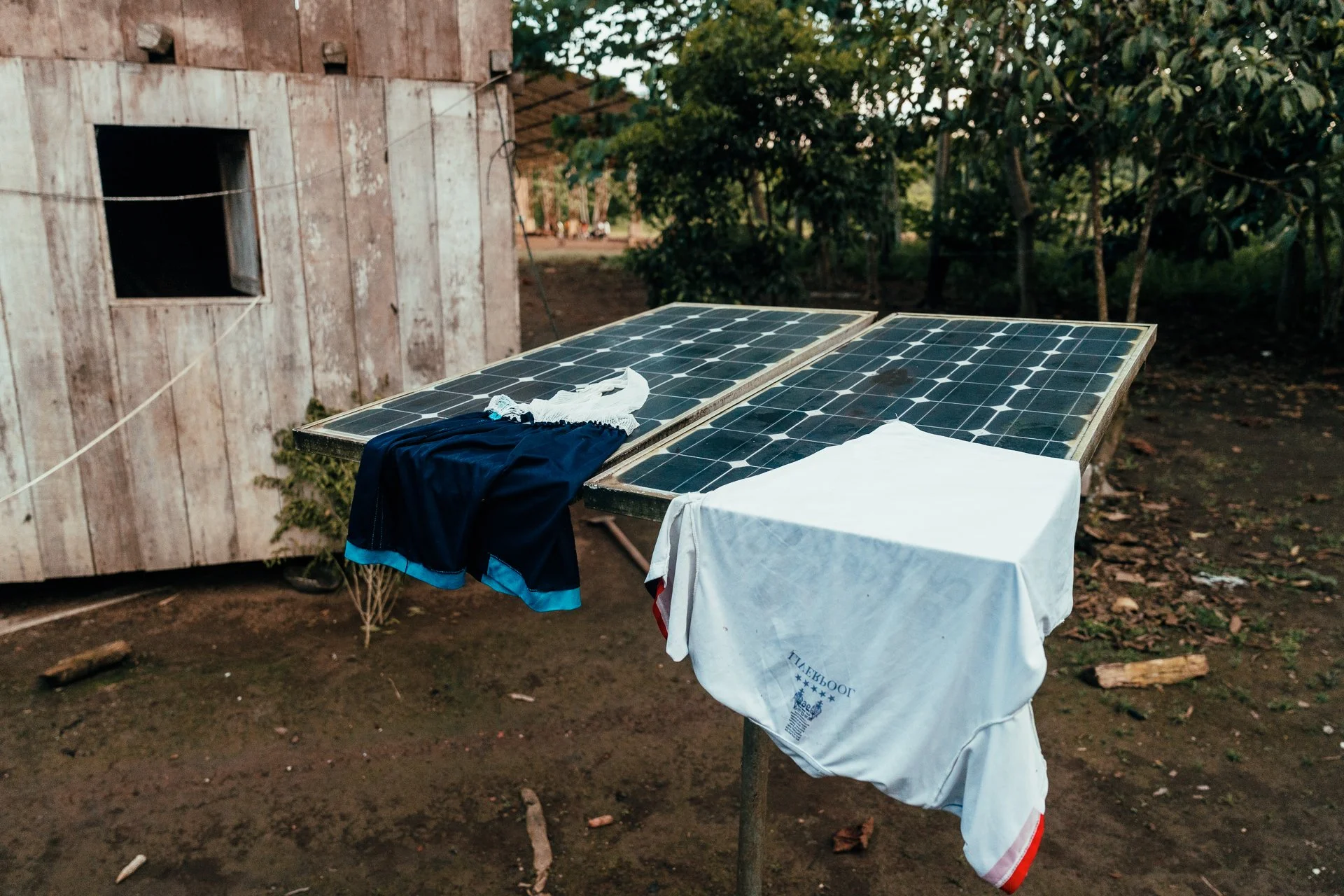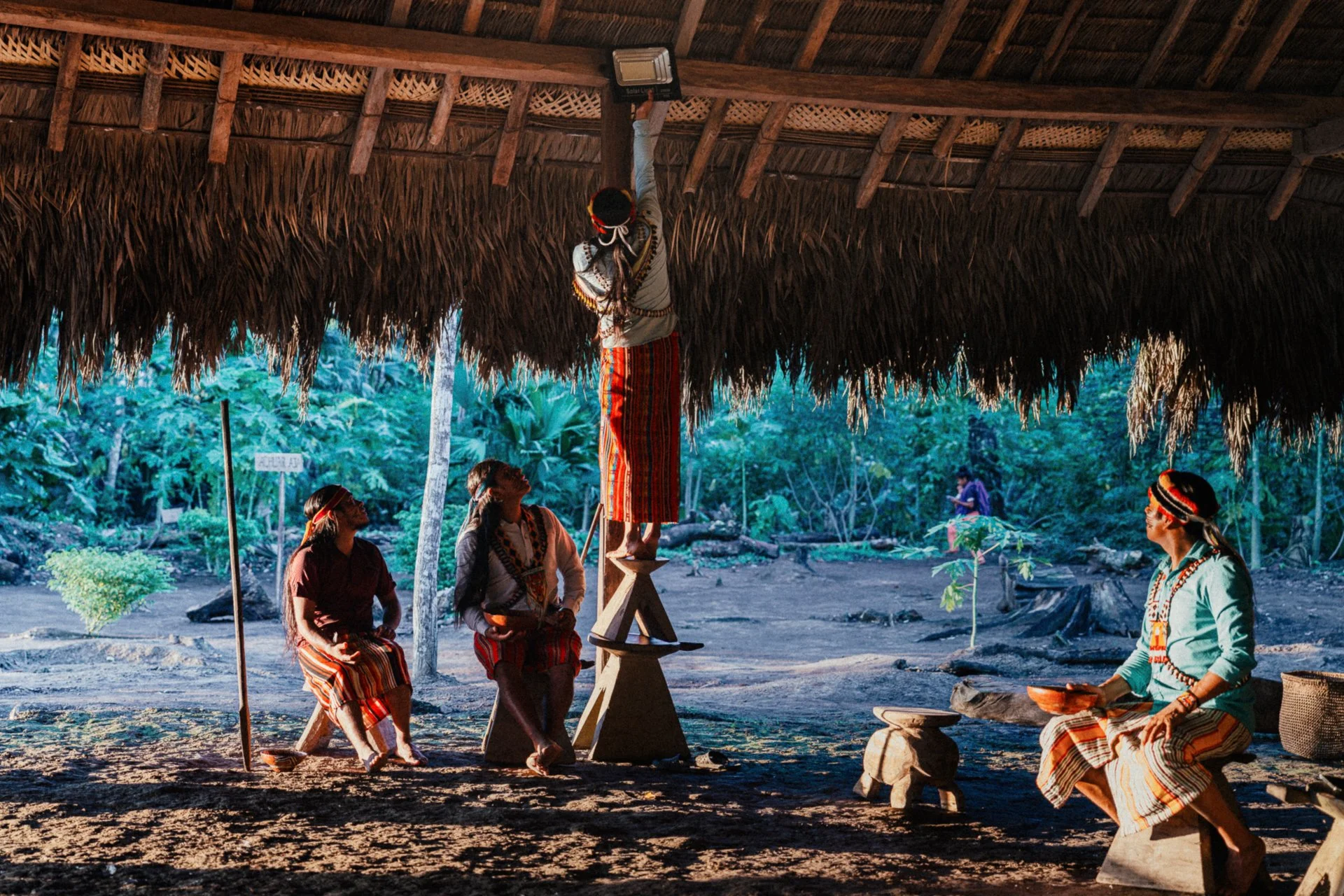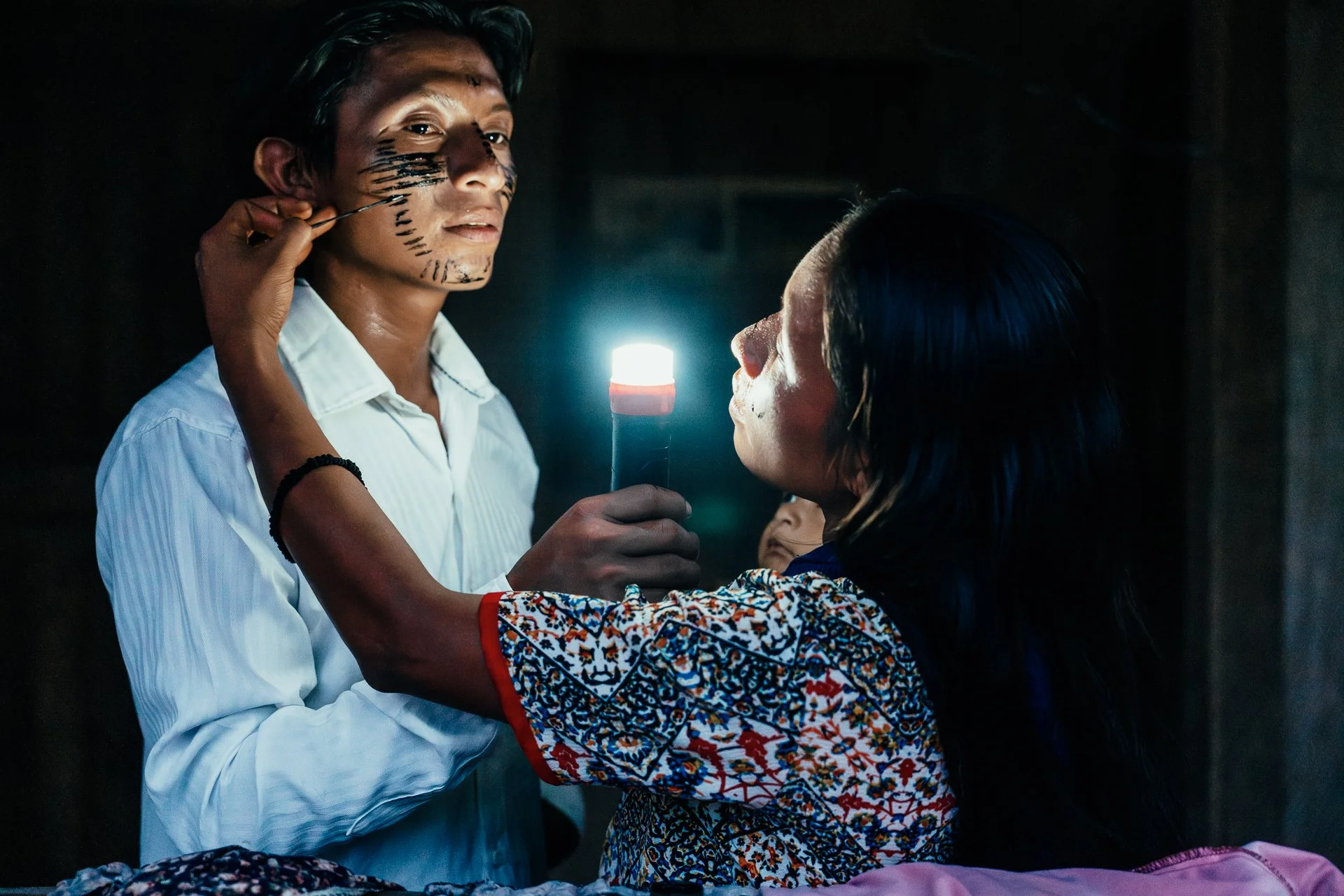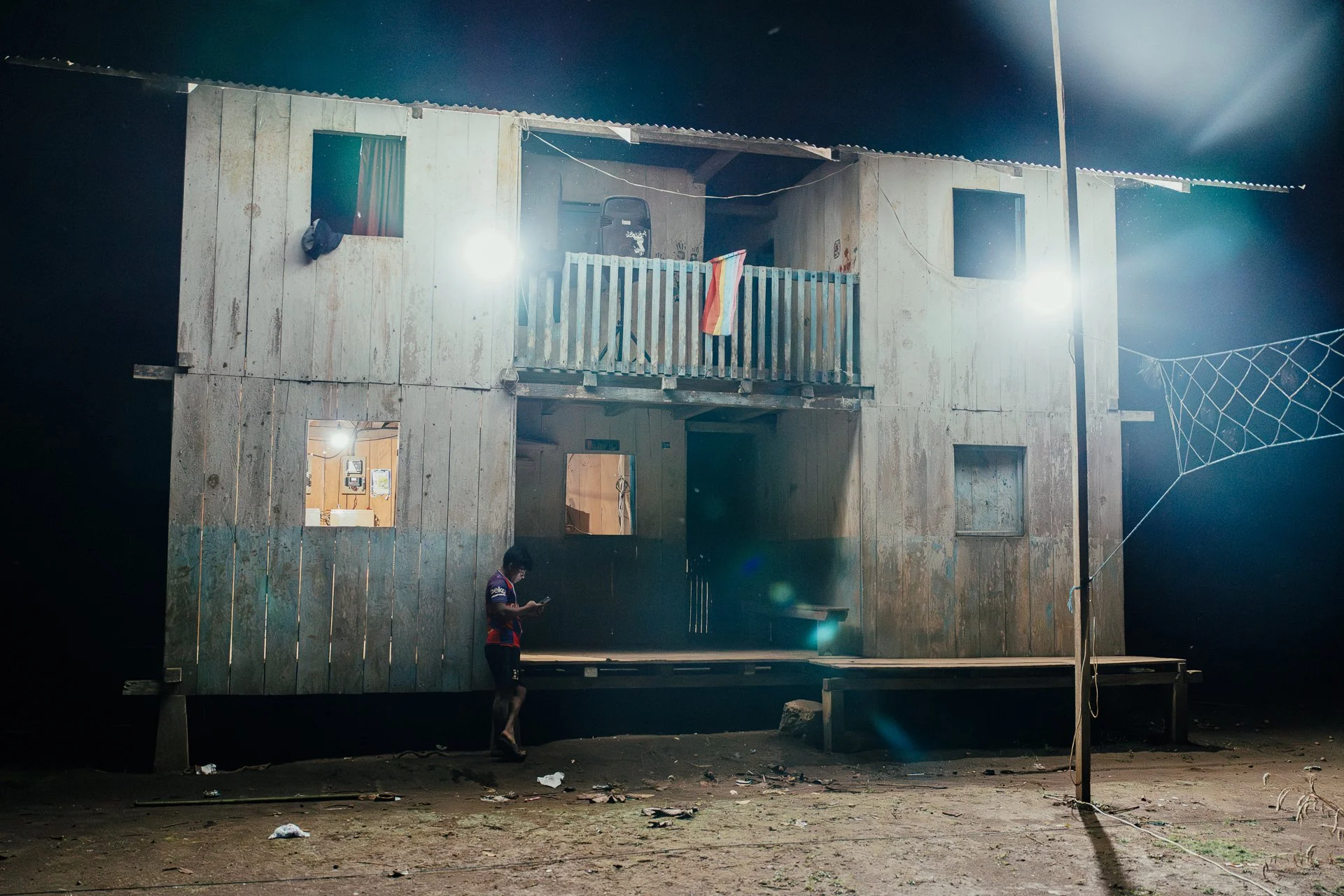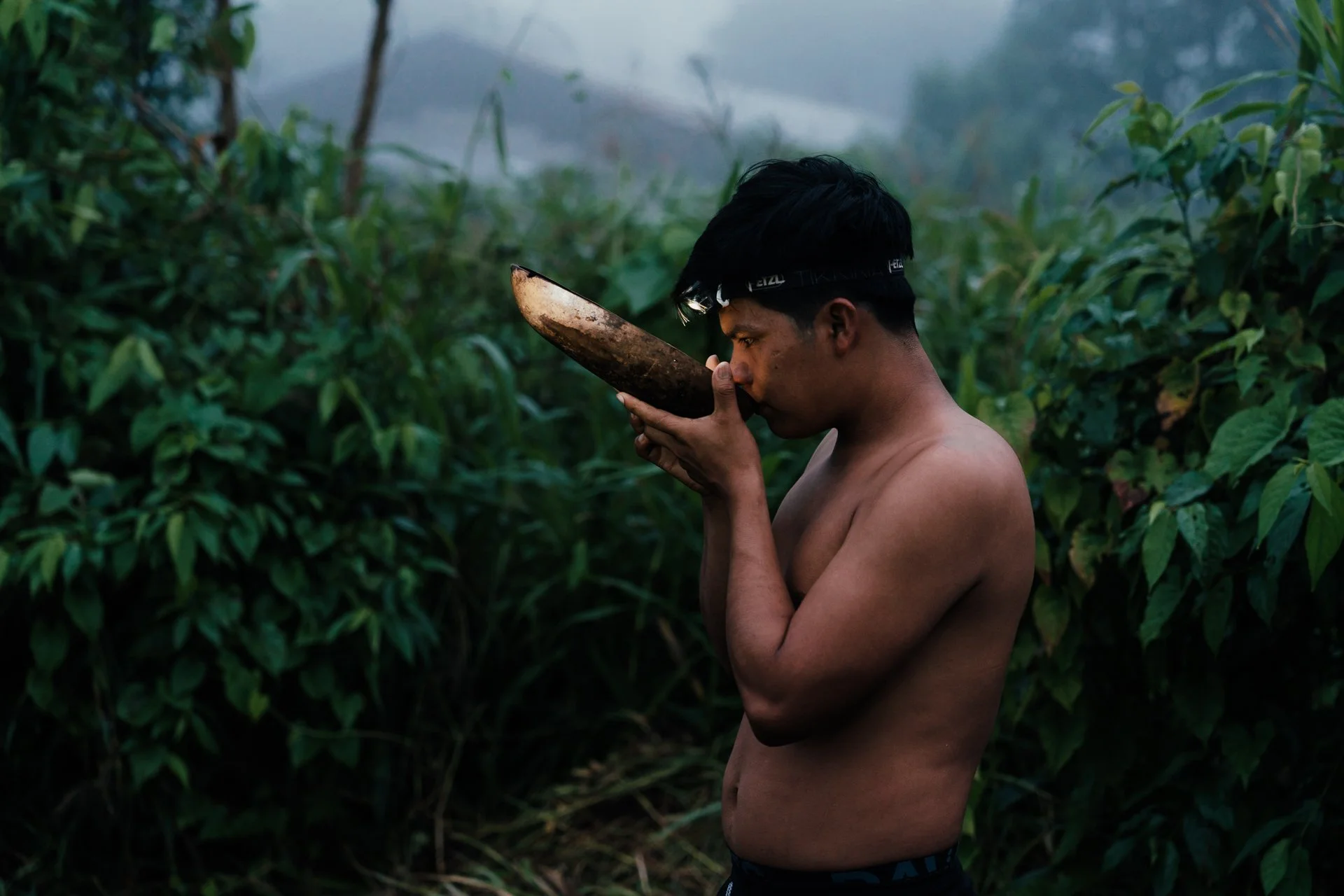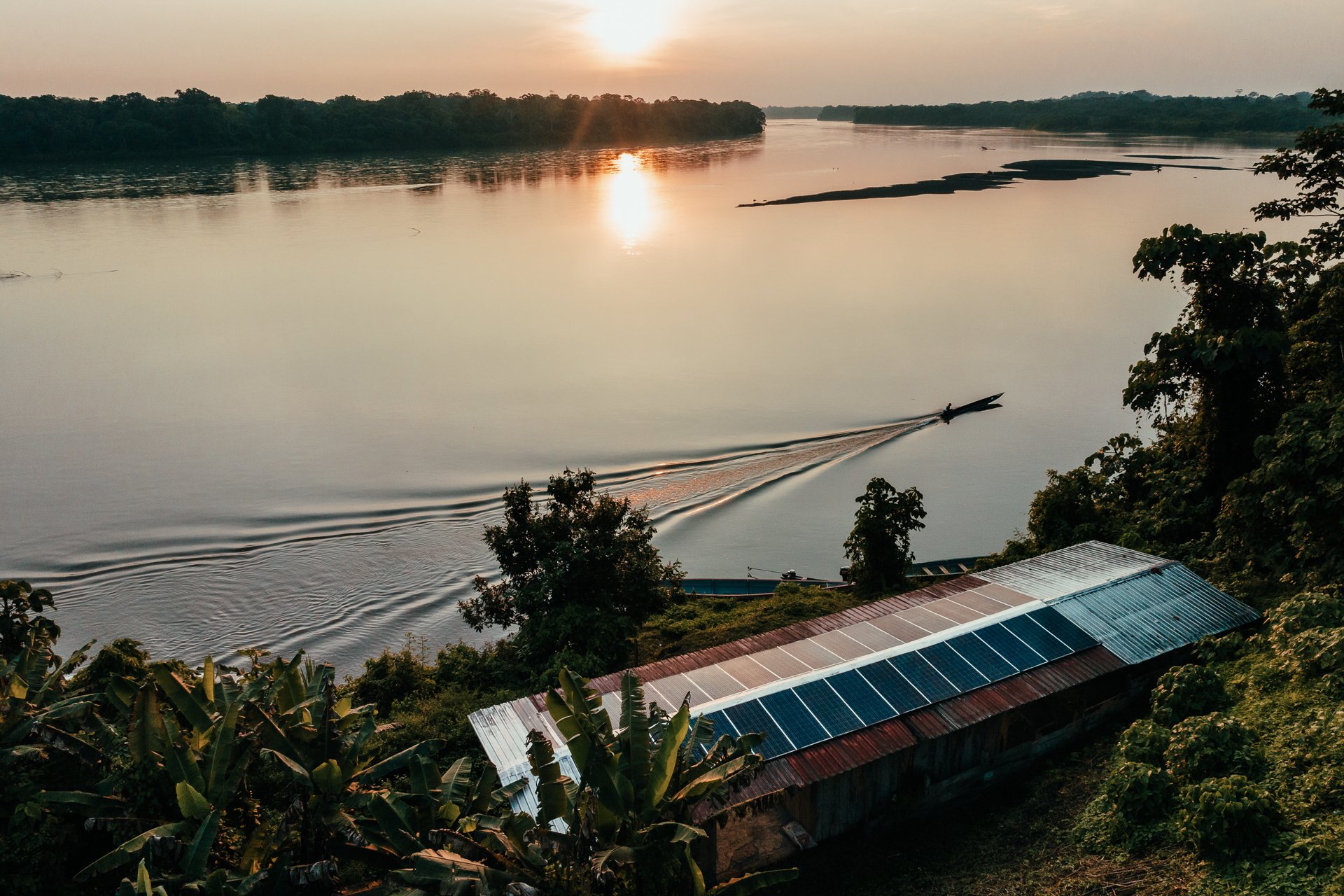Photos by Misha Vallejo Prut
This story was produced with support from the Rainforest Journalism Fund in partnership with the Pulitzer Center.
The sun illuminates the struggle of the Achuar in the Ecuadorian Amazon
More than 20 years ago, Nantu Canelos had a dream: Sharamentza was illuminated. In Kapawi, another community in the Ecuadorian Amazon, Óscar Mukucham also dreamed that the sun lighted his home at night. In Wichimi, the vision of a boat moving with solar energy appeared during dream rituals.
Images that, for those with electric light may have no relevance, in this case illuminated the path for the Achuar territory to become the center of a solar revolution. The three visions occurred in three different communities, located in the first and second provinces with the least electricity coverage in the Ecuadorian Amazon: Morona Santiago and Pastaza. Both are also among the four provinces with the least access to this service in Ecuador and have the highest levels of poverty.
Although most of the exported oil - which generates revenues of around US$3 billion a year - is extracted from the Ecuadorian Amazon, its inhabitants have the least access to electricity, water and employment. On the other hand, they must buy gasoline in the cities to move along their only roads, which are the rivers, and to have light, for two or three hours a day.
In search of energy independence and avoiding the consumption of fossil fuels, coming from the extractive activities they are fighting against, the Achuar have implemented a new model based on solar energy, both for their homes and for their transportation.
Their schools are being illuminated, their rivers are becoming clearer and their message of no roads and no extractive activities is gaining strength as they have a new alternative. Just as the sun makes life possible on the planet, it also allows the Achuar to maintain their culture.
It all started with the boats
In the midst of the "peque peque", which are small boats with engines that announce their arrival from several kilometers away, Wampi moves silently. Unlike the first ones, this one moves slower and leaves no traces of gasoline in the water.
Wampi, which means fish in Spanish, carries nine panels on its roof, which power its journey down the Wichimi River. This is the first and only solar boat in the province of Morona Santiago and the third in Achuar territory.
On this occasion, Domingo Mukucham parked it in Puerto Nunkui to receive the Kara Solar team. This is one of the projects that supports the Achuar in their transition to solar energy since 2018, when they delivered the first boat to the community of Sharamentza, in the province of Pastaza.
Later, another boat started to work in Kapawi, also in Pastaza, and finally Wampi was built in Wichimi, in Morona Santiago. Oliver Utne, founder of this initiative, says that, in each place, the locals are in charge of its care and of establishing the routes and the function of the boat.
From the beginning, the inhabitants of each community were trained as technicians and now they are the ones who transmit the knowledge to the new Achuar communities that adhere to the path of solar energies. This project seeks to change the traditional model of subsidizing transportation with fossil fuels and, on the contrary, subsidize one based on clean energies.
The Achuar technicians and other members of the foundation arrived at Puerto Nunkui in April to begin a 10-day tour of the communities where the boats operate. Puerto Nunkui, in the Amazonian town of Taisha, is the last point that can be reached by vehicle. From there, the only way to go to Wichimi is by river or light aircraft (USD 400).
After picking up the team, Domingo sails relaxed back to the community. The same goes for the passengers. The calm that Wampi transmits acts as a sleeping pill for all the crew members, who enjoy the four-hour ride lying under the paneled roof and huddling in the breeze coming in from the sides of the boat.
As they sail down the Wichimi river, Domingo checks the device that gives him the boat's battery percentage, speed and power. "The roof panel is charging as we are going," he says proudly.
Energy against pollution
For two years, Domingo has been making this round trip with eight passengers every Saturday. The community decided that the boat in Wichimi would allow people to travel to the city without paying USD 5 one way and USD 5 return, which is the cost of traveling by "peque peque".
The free boat has especially helped the mothers of the community who have to collect their vouchers, sell products or buy clothes for their children in Taisha. "I spent all my money to pay the "peque peque" and I couldn't afford to buy the materials my children needed for school," says Rosalinda Mukucham.
For this mother of five children, Wampi has become a support to get to Taisha. Before, those who did not have money for the ticket had to walk up to five hours to that city.
Rosalinda, known as Yajanoa (woman from far away) in the Achuar language, says that the boat has also helped them in emergencies and to take them to their chakras, which are on the other side of the river.
In addition to improving mobility, the idea is to reduce pollution in the river. Lucia Chumac recalls that 10 years ago, before the first "peque peque" arrived, the water was clean.
"We know it is polluting, but for now we need it," tells this inhabitant of Wichimi, while she combs the hair of one of her five daughters, who returned from bathing in a small lagoon.
The girls try to bathe in this water source, although they still do it in the river, where they also wash their clothes.
This water has already begun to cause impacts. "Before, we all drank from the river and it caused diseases such as dysentery, diarrhea in children and adults, and skin diseases due to oil fuel spills," says Patricio Mukucham.
The Principal of the Muku Educational Unit, who was one of the main promoters of the solar boat in Wichimi, went to the doctor at that time to corroborate the theory that they were bathing in water contaminated with burnt oil and gasoline.
With this evidence, the Wichimi authorities convened an Assembly in January 2023 and decided that no water would be taken from the river. In addition, they prohibited the "peque peque" from parking in the port of Wampi, so that the area would be cleaner.
The river has begun to recover, says Patricio Mukucham. The idea is that, little by little, fewer people in Wichimi will need to use the "peque peque" and that the number of solar boats will grow, in order to abandon the fuel-dependent transportation model.
Panels promote education
Domingo also uses the boat to transport children from nearby neighborhoods to the Wichimi school. Together with his partner Pablo Simo, they pick up those who live on the other side of the river, starting at 6:30.
Parents keep an eye out for Wampi's arrival and, upon seeing him approaching, walk down a muddy slope to drop off their children. Simo helps carry them and places them in the seats. The little ones enter with their shoes in hand, so as not to stain Wampi.
Before the boat existed, the children had to cross a suspension bridge to get to school. When it rained, they would cover themselves with large banana leaves, but the biggest risk was that they would fall into the river.
"The older ones, who went ahead in the early morning, would fall into the water because the river covered the planks of the bridge," recounts Nela Atamain, teacher of Mathematics, Literature, Art and Drawing. Thanks to this "school bus", 15 children from this area are now able to attend school, whereas previously only six used to go. After midday, Domingo and Pablo take them back to their homes.
The panels have lengthened the study hours. When evening falls, Patricio Mukucham's home becomes a meeting point. Outside his house, located next to the only airplane runway in Wichimi, the solar panels stand out, with which he has light and Internet at night.
With these devices, he lights a study room where his children and other members of the
community do their homework, use the computer and charge their cell phones. Ten years ago, this teacher was the only one with the panels, which he bought in the city.
Now, his house is one of the three with Internet in the community and one of the 32 with solar panels, delivered by the public company Centro Sur. In this case, they have to pay USD 1, 50 per month to keep them working.
The problem is that the elderly and mothers often do not have enough income to pay for this service. This is related to data from the Survey of Employment, Unemployment and
Underemployment of 2022, which shows that Morona Santiago is the poorest province in the country. 65.8% of its inhabitants live in poverty.
Among the plans of its 180 inhabitants are to find ways to work together to finance panels for each house, use solar energy for lighting in communal areas, have more local technicians and increase the frequency of trips to Nunkui.
Kapawi seeks solar knowledge
Half an hour by plane from Wichimi, is the Achuar community of Kapawi. Located in the
Amazonian province of Pastaza, this area is in another phase of this solar revolution: knowledge.
On the morning of April 12, the energy in the Las Tunas Educational Unit was different. Óscar Mukucham and the other Achuar technicians entered the computer room with drills, cables and outlets.
A few stacked computers, dusty CPUs and neglected, but almost new, desks showed the use that had been made of this space. With no power and no money to buy a gasoline generator, it was impossible for teachers to use this classroom. But that morning the situation would begin to change.
At noon, Óscar officially announced that the computer room had solar power and Internet. Bernabé Aragón could not hide the excitement he felt knowing that, after 20 years, the young people would be able to use the computer room.
Carrying his laptop, he encouraged the other teachers to enter the classroom to try out the technology.
This systems engineer arrived from Puyo, one of the main Amazonian cities, three years ago. One of the things that affected him the most was the lack of light and not being able to transmit his passion for technology to his students.
As soon as he arrived, Aragón bought a solar panel, batteries and solar lights. The problem was that they were used and already worn out. So he had to buy a generator, that works with gasoline, to supplement them. For two hours of light, he spent USD 100 a month on gasoline.
His house became a small technology center. Students and other inhabitants of Kapawi went every night to connect to the Internet or charge their devices outside his house.
That April 12, he got another piece of good news: the Solar Center's panels could also power his house 24 hours a day, so he could continue to share it with the community.
The first thing he did with his newfound energy was to print out tests for the students. "I want to teach them about computers, about technology and the correct use of the Internet, which is very important," he said, as he ran to the classrooms.
Another of the spots that will be illuminated is the center that houses students from other areas. This school receives students, from five to 20 years old, from other 15 communities.
There, some like Denisse Canelos went ahead and brought their own solar lamp to do homework at night. Those who don't go to Aragón's house, settle in this young man's room to finish their homework. Occasionally, they take the light out into the courtyard to cook in the evenings.
"I want the Achuar youth to become interested in making panels and batteries and even a robot," says Luis Mukucham, principal of the Kapawi Educational Unit. Excited by the progress of solar energy in the community, he even plans to create a subject aimed at reinforcing this knowledge.
At the Solar Center, which is located in front of the Pastaza River, workshops on mechanics, renewable energies and electrical systems are already being held by the Achuar technicians who know the most about these subjects.
Óscar Mukucham is one of the most involved in this project and the one in charge of taking care of Sunkirum, the solar boat of this locality. At 23 years old, he is sure that solar energy is the future of his community.
"Now that we are in times when the oil companies want to invade us, we young people are determined to use this energy to prevent them from entering," says this Achuar.
Solar energy for tourism
The vision Óscar had when he took the medicinal plant Ayahuasca, when he was 11 years old, motivates him to work to make this dream come true. Óscar takes other young people on boat rides to nearby sites to show them the benefits of solar energy.
He also transports students from the Tunas Educational Unit to do their internships at the Kapawi Lodge, a hotel managed by the community. The particularity of this place is that it has 24-hour energy, thanks to the sun.
There, the young people can see first-hand the potential of solar panels. Each month the hotel receives up to 100 tourists. While José Chariguamán shows the facilities to the visitors, he explains the benefits of having 64 panels that illuminate the 10 cabins, the dining room and the hotel facilities. The idea is for visitors to relax, listen to the sounds of nature and learn that it is possible to live in harmony with the environment.
"It's an incredible thing to have light in all the Lodge facilities. There is no noise, no smoke and no pollution. This way we keep the rivers and medicinal plants healthy, and we prevent the animals from being scared away", says Chariguamán, who is one of the lodge's administrators.
This hotel is also managed by two other Achuar communities: Sua and Kusutkau. Together with Kapawi, they are in the process of creating an association to continue showing and preserving the Achuar culture.
Solar energy for daily life
In another community of Pastaza, a solar spotlight illuminates the ‘guayusa’ ritual, which begins at 4:00, in the house of Nantu Canelos. In this space, the Achuar use to tell their visions. In these meetings, together with the elders of the community, they have shared their dreams of an illuminated Sharamentza, as it is now.
In this community, the communal spaces and its 28 houses already have solar lights, which were donated by Nia Tero, another foreign foundation focused on the Amazon. This light allows them to get together to cook and have dinner later in the evening or even provide music and light for their parties.
The lamps are placed at strategic points such as the volleyball court. "The kids saw snakes crossing there, and I just got bitten by one. We couldn't take any more risks," Canelos says. On that occasion, he was bitten by a venomous X snake, and had to leave that night by boat to Kapawi and at dawn by plane to Puyo.
Since that incident, they placed lighting in the most risky areas and have not had this type of event. The Internet is also powered by the sun and the inhabitants of Sharamentza no longer have generators. "It cannot be that we talk about the fight against extractive activities, if we are consuming fuel," Canelos says.
Solar energy has become part of the daily life of this community, which has plans to continue expanding. They now have a center with panels and their idea is to illuminate the tourist cabins.
In Sharamentza there is also Tapiatpia (electric fish), which is the largest solar boat in operation. It has 30 panels on the roof and 12 lead batteries. Luciano Peas is in charge of driving it. Once, he recalls, thanks to the Tapiatpia's silent engine, he was able to see dolphins at close range. He has also used it to take tourists to see birds and other animals.
During the Covid-19 pandemic, due to gasoline shortages, the boat helped transport people to other communities. Peas recalls making six to eight trips a week. In addition, during the 2020 balsa wood extraction rush, Tapiaptia functioned as a tool to monitor the territory. At the time, wood was being extracted from the Ecuadorian Amazon for export to China, which required it to build wind power plants.
"Solar energy gave me the opportunity to learn electricity and teach others," says Peas, who connects to the Internet at night to watch tutorials on these topics. He is also learning more languages to chat with the 20 or so tourists who come to Sharamentza every month.
For Nantu Canelos, the most important thing is to continue transmitting knowledge. In his eagerness to share with technicians from other communities, he has given virtual and other face-to-face workshops in countries such as Peru, Brazil and Suriname, where solar boats are about to start operating.
In Ecuador, three more boats are expected to be incorporated into the Amazonian rivers. "We have a great task to strengthen those aspects to become independent in energy issues and move to solar energy," he reflects during the ‘guayusa’ beverage ritual.
Although they still have to resolve issues such as the duration of the batteries to travel longer distances or more boats that really discourage the use of the "peque peque", they are clear that the sun is their fighting tool to prevent the construction of roads or the entry of oil companies.
In each community, the Achuar continue to look for ways to encourage solar energy. In Kapawi they are negotiating the arrival of more panels with other foreign foundations and are devising projects so that every house has solar light.
Some, like Óscar, dream of building a solar aircraft and even an airport. Despite being open to new technologies, the new vision of Nantu Canelos and his companions is clear: "to use energy to communicate to the world, but from the territory".
